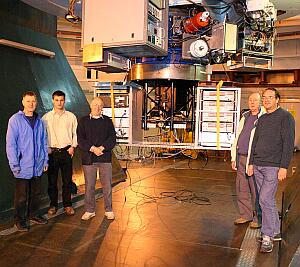First light (at ING): 22 April 2004.
Designed and built by: University of Hertfordshire Astrophysics Group.
Description: Following the detection of extrasolar planets by the radial velocity method in the mid-1990s a global effort began to try and detect these planets directly. The radial velocity method pioneered by Mayor & Queloz and Marcy & Butler provides a great deal of information about planetary orbits, including the fact that many planets orbit very close to the parent star (which are known as "hot Jupiters"). However this indirect technique leaves an uncertainty in the mass of the planets and their orbital inclination, measuring only M.sin(i). It also provides no information about the composition of the planets themselves.
A number of groups are attempting to remedy this by directly observing extrasolar planets using high resolution interferometric imaging to pick out faint companions, or high resolution spectroscopy to distinguish reflected light from the planet using the wavelength shift caused by the Doppler effect.
PLANETPOL is the attempt to directly detect hot Jupiter planets via the polarisation of their reflected light, see Hough, Lucas, Bailey & Tamura; 2003, SPIE 4843, 517. PLANETPOL is an optical aperture polarimeter funded by PPARC. Since the planet is spatially unresolved from the star, the polarisation fraction from hot Jupiter systems is only a few parts in a million. When PLANETPOL is mounted at the Cassegrain focus of a 4-8m telescope it receives sufficient photons from a V=5 star to measure such a signal in less than 1 hour. A number of larger polarisation signals are also detected: eg. telescope polarisation, instrumental polarisation, interstellar polarisation and sky polarisation. However, only the signal from the planet will rotate at the planet´s orbital period, which is known from radial velocity measurements. PLANETPOL has a sky channel to measure sky polarisation so that this can be subtracted if necessary (it is insignificant on dark time). The object and sky channels are both dual beam systems, using 3-wedge Wollaston prisms to send the light to four separate thermoelectrically cooled Avalanche Photodiode detectors. The modulating element in each channel is a Photoelastic Modulator or PEM, which provides a retardance oscillating sinusoidally from zero to Pi at 20 kHz.
Owing to the differential nature of PEM-based detection and the use of large apertures the instrument can operate in non-photometric conditions and in poor seeing.
PLANETPOL has the potential to:
(1) measure sin(i) and hence the planetary mass, being sensitive at any orbital inclination (i).
(2) Determine planetary albedo and radius. Detection at BVRI will provide good precision for these observables.
(3) Determine the optical properties, size and perhaps composition of the reflecting particles in the planet´s atmosphere.
Time allocations:
Nights scheduled since semester 2007B
More:
- http://www.ing.iac.es/PR/newsletter/news9/ins1.html
- Hough , J H , Lucas , P W , Bailey , J A , Tamura , M , Hirst , E , Harrison , D & Bartholomew-Biggs , M 2006 , "PlanetPol : A very high sensitivity polarimeter", Publications of the Astronomical Society of the Pacific , vol 118 , no. 847 , pp. 1302-1318 .
Research impact:
Publications (9 from ING paper count)
Multimedia:
Photo archive (2)



